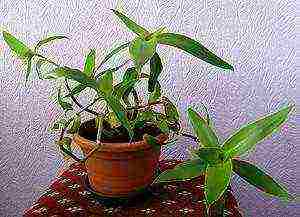Content
- 1 Brunner's features
- 2 Brunner's landing
- 3 Brunner's care in the garden
- 4 Wintering
- 5 Main types and varieties with photos and names
- 6 Modest beauty from the Caucasus
- 7 Convenient location
- 8 Breeding methods - it couldn't be easier
- 9 Secrets of proper care
- 10 When and how to plant Brunner
- 11 How to care for a Brunera flower
A plant such as brunner or brunner (Brunnera) is directly related to the genus of herbaceous perennial plants of the borage family. This genus unites 3 species. These plants are found in natural conditions in Western and Eastern Siberia, the Caucasus and Asia Minor. This flower was named after the Swiss S. Brunner, who is known as a traveler and botanist. Only 2 species of brunner are cultivated, namely: Siberian and large-leaved. These plants are most often used to create borders and for stable decorative groups in mixborders.
Brunner's features

Brunera is a herbaceous plant that is a perennial, a bush in height can reach 45-50 centimeters. There is pubescence on the surface of branchy shoots. Large one-piece long-petiolate leaf plates have a wide-heart shape. Small blue flowers (0.5–1 cm in diameter) are outwardly similar to forget-me-nots, therefore such a plant is also popularly called a forget-me-not. Such flowers are part of paniculate or corymbose inflorescences. Flowering begins in April and lasts 4 weeks, possibly re-flowering in autumn. The flower of this plant differs from forget-me-not in that the spot inside it is painted not yellow, but white. The fruit is a nut. Such an undemanding plant in the care, growing, forms spectacular thickets. It is winter-hardy, but does not feel well during the dry hot period. Bruner can be grown for about 15 years without transplanting in the same place.
Brunner's landing
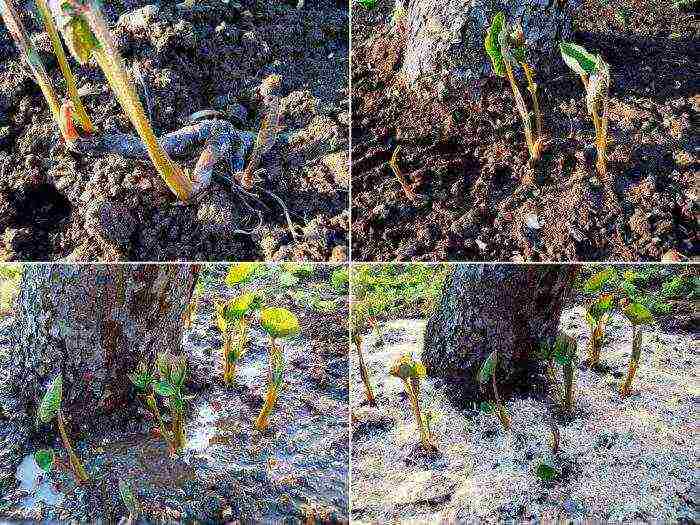
Such a plant in natural conditions prefers to grow in the forest, in this regard, it is shade and moisture-loving. When choosing a site for planting, be sure to take this into account. In hot areas, it is necessary to choose a shaded area for planting bruners, since the scorching sun rays can destroy it. In areas with a less hot climate, planting this flower should be done in a slightly shaded place, or you need to choose an area that will be in the shade after lunch. If you plant it next to a pond, then such a plant is able to withstand the direct rays of the sun. Clayy wet soil is suitable for planting, while the Siberian brunner is more demanding on the composition of the soil than the large-leaved one. Disembarkation, as well as transplantation, are carried out in the last days of July or in the first days of August. Bruner's spring transplant is very poorly tolerated. At this time, only large-leaved bruners can be transplanted, while it is necessary to take an earthen lump of a relatively large size. Disembarkation should be made in the evening or on a cloudy day.
How to plant correctly
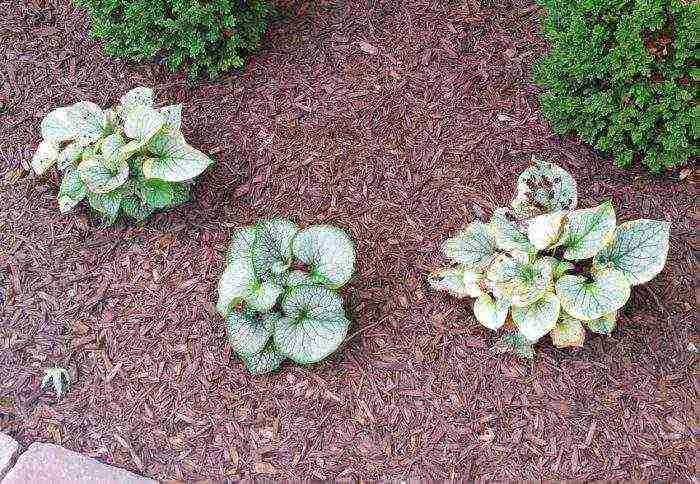
Most often, the planting of large-leaved brunners is combined with the division of the flower. After the bush has faded, it must be dug up. Then the root system must be freed from the soil, while immersing it in a container of water. After that, the bush is divided into parts, while adhering to the natural collapse of the rhizome. If necessary, a very sharp, pre-sterilized knife should be used to cut the rhizome.When dividing, it should be borne in mind that roots should be present on each division, as well as a recovery bud of the next year. Plant the cuttings in the holes, and then water them well.
Brunner Siberian can be propagated by segments of rhizomes. It is located very close to the ground surface. From the excavated rhizome, it is necessary to cut out old areas, as well as those on which there is rot. Then it is divided by breaking in such a way that on each resulting cut there is a living bud of renewal. The length of the cut can vary from 4 to 6 centimeters. Each piece is planted separately, buried in the soil by 2-3 centimeters, then it is watered very well.
When the plants are planted, the surface of the soil is sprinkled with a layer of mulch (limestone, sawdust, bark, wood ash or coffee grounds).
Brunner's care in the garden

The rules for caring for the Siberian Brunner and the Large-leaved Brunner are different. The large-leaved brunner retains an attractive appearance throughout the growing season, and if you choose the right place for it (shaded with wet soil) when planting, then you can forget about leaving it until autumn time. All that this species will need is systematic weeding, which must be carried out without fail, but it should be borne in mind that it is impossible to loosen the soil, because the root system of the plant is located very close to the soil surface.
After the Siberian brunner has faded, brownish specks will begin to form on its leaf plates. Then the leaves will begin to fade, and it is recommended to remove them in the middle of summer. In the second half of August, young leaves should grow in the Brunner, which are able to hold out until the first frost. This species is not afraid of weeds, it also does not need watering (there is enough natural precipitation) and loosening of the soil, because the root system is also located quite close to the soil surface. If the summer is very hot, then the Brunners, regardless of the type, will need to be watered periodically, immediately after the leaves begin to droop.
Breeding brunner

The above describes in detail how to propagate brunner by dividing the rhizome. It should be borne in mind that variegated forms can only be propagated in this way. It is quite possible to grow a species brunner from seeds, however, due to early frosts, it rarely has time to set seeds. But you can always get the seeds of such a plant in a specialty store. The seeds of this flower are very small. It is recommended to sow them in open ground before winter (in autumn). For spring sowing, the seeds must be prepared, for this they must be subjected to stratification, which lasts 3 or 4 months. To do this, they can be sown in a box and then buried in the snow outside, but the easiest way is to put them on a refrigerator shelf. It should be borne in mind that it is much easier to propagate a Brunner by division than by seeds, and even more often it reproduces itself by self-seeding.
Pests and diseases
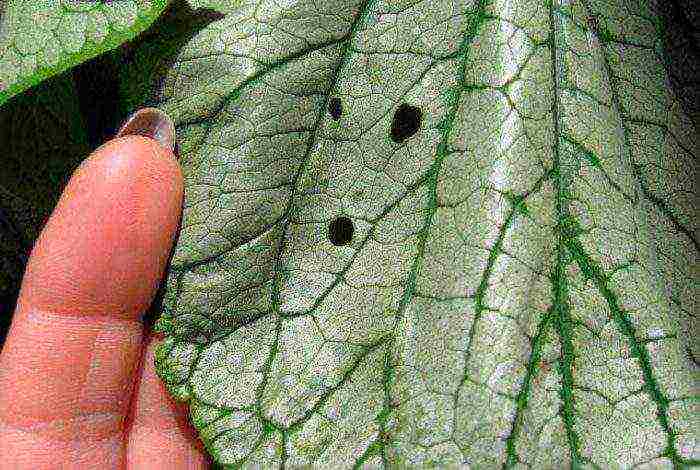
If there is a lot of rain in the summer, then such a plant may develop brown spot, the spots that have appeared on the leaf plates will testify to the infection. Brunera can also become infected with powdery mildew. In a diseased specimen, all infected parts must be removed, and then it must be treated with any fungicidal agent (for example, Bordeaux mixture).
Whiteflies and aphids can also settle on this flower. To destroy them, it is recommended to process the bush with Karbofos or Aktellik.
Wintering
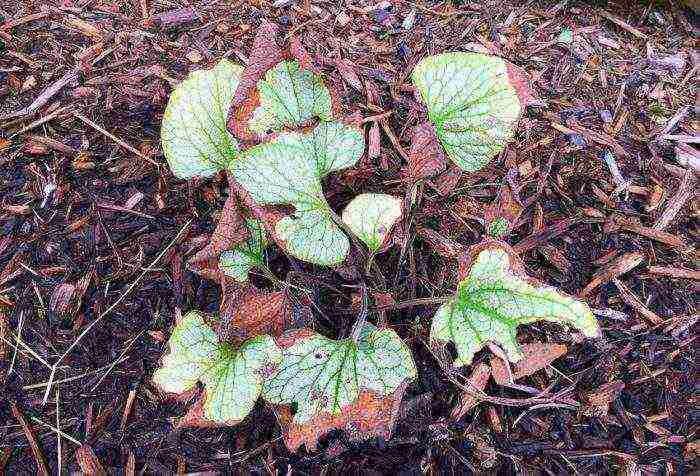
It is very easy to prepare Brunner for the coming winter. Leaf plates must be cut off in the fall, since they themselves do not die off. It is not necessary to cover these flowers, because they are quite winter-hardy, however, experienced gardeners recommend covering the area with a layer of mulch (peat, compost or humus).
Main types and varieties with photos and names
Brunner large-leaved (Brunnera macrophylla)

In natural conditions, it can be found in the Caucasus Mountains, in this regard, the Germans also call this plant "Caucasian forget-me-not." It looks like a bush. Branched leafy shoots extend from the rhizome, their surface is rough-pubescent. The bush reaches a height of 30 to 40 centimeters. Basal long-petiolate leaf plates have an oblong-heart-shaped shape with a pointed upper part. Their front side is colored dark green, and the back side is grayish, because it is rough and has pubescence. Small (about 0.7 centimeters in diameter) dark blue flowers have a white center. They are part of the apical inflorescences of the paniculate-corymbose shape. Flowering begins in the last days of April and lasts 4 weeks. If it is warm in the autumn, then re-flowering is quite possible. It has been cultivated since the 19th century.
Popular varieties:

- Millennium Zilber... There are large whitish-silvery spots on the leaf blades.
- Jack Frost... The leaf plates are colored silver, and green veins are clearly visible on their surface. There is a narrow green edging.
- Hudspan Cream... The length of the wide heart-shaped leaf plates is about 15 centimeters. They have a narrow edging of a creamy white color.
- Langtries... There are small silvery dots along the periphery of the dark green leaf plate. The flowers are blue.
- Variegata... On the leaf plates there is a wide strip of creamy white color, which extends over the green part with deep tongues. Shrubs growing in sunny places have almost white leaves.
Brunner Siberian (Brunnera sibirica)

In natural conditions, it is found in the forests of Altai and Sayan. This species is much larger and more beautiful than the large-leaved brunner. The long rhizome is about 10 millimeters thick. The glandular-pubescent shoots are solitary and can reach a height of 60 centimeters. This species forms thickets. Dense basal heart-shaped leaf plates have a long petiole and a wrinkled surface. Stem leaves sessile, almost lanceolate. Small (0.5 centimeters in diameter) dark blue flowers have a white center. They are part of complex paniculate inflorescences. Flowering begins in May and lasts 20 days.
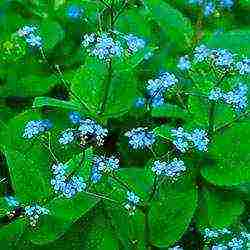 Every zealous owner wants to decorate the garden with a spectacular and unpretentious plant. And bruner comes to his aid, striking with a heart-shaped shape of patterned leaves and delicate small flowers that look like forget-me-nots. Planting it in open ground is easy, but care requires compliance with some rules. Choose a variety according to the photo in the catalog, study the information - and make your site a paradise!
Every zealous owner wants to decorate the garden with a spectacular and unpretentious plant. And bruner comes to his aid, striking with a heart-shaped shape of patterned leaves and delicate small flowers that look like forget-me-nots. Planting it in open ground is easy, but care requires compliance with some rules. Choose a variety according to the photo in the catalog, study the information - and make your site a paradise!
Beauty Brunera: description
Bruner flower is a borage family. It is distinguished by significant growth - 55-60 cm, as well as pubescence of the petioles, on which powerful leaves in the form of a heart are held. An adult flower looks more like a shrub than a herbaceous plant, so it is used not only as gardening for flower beds, flower beds, but also as a green hedge.
A striking feature is pale blue flowers (7-10 mm in diameter) with a white center, similar to forget-me-not flowers. This is the difference from the forget-me-not, in which the core of the flower is yellow, and also the second name, the forget-me-not.
Despite the popularity of bruner, the flower has only 3 species (Siberian brunera, whose flowers are rich in blue, large-leaved brunera, striking decorativeness, oriental brunera, which is not cultivated) and about 30 varieties. Each of them will delight you with a certain shade and pattern of leaves, the height of the bush, and the peculiarities of cultivation. You can choose a variety:
- Variegata, which will conquer with emerald green foliage and snow-white edge. Feature - the height of the bush is 35 cm;

Variegata
- Silver Hut, striking with silvery heart patterns on the leaves. The main advantage is undemanding to soils and the ability to grow in direct sunlight without losing decorative properties;

Silver Hut
- King Ransom will appeal to anyone who loves a mix of green, silver and cream. An important feature is the height of the bush, which can reach 75 cm;

King Ransom
- Jack Frost, who is covered with frost. An important rule of care is spraying;

Jack Frost
- Looking Glass, which will appeal to those who love undersized varieties. The height of the bush is up to 20 cm, the flowers are up to 7 mm in diameter, the foliage is silvery.

Looking Glass
Attention! When choosing a variety, pay attention to the peculiarities of growing and do not plant 2 different varieties next to each other. This will make it difficult to leave!
Planting bruners in open ground: important points
Having decided to decorate your own garden with a bruner, you made the right decision. She is so unpretentious that even an experienced florist will be amazed. It is enough just to remember that the flower does not tolerate direct sunlight, which causes burns to the leaves and loss of decorative effect. Therefore, the best place is partial shade or shade, the location is closer to the water. In this case, you will not need to water the plant once again, but it will delight you with an amazing color of foliage all season!
But if leaving does not require much labor, then planting a new bush is the opposite. You should stock up on time, patience - and then more than one bruner bush will decorate your garden.
Usually, planting a new bush is associated with dividing an old one that has already grown. Taking into account the fact that brunera is capable of living in one place for up to 15 years, it can be divided and reproduced every 3rd year. This requires:
- cut the mother bush to a height of 15-20 cm. Time for dividing the bush and planting - late July-early August;
- dig up the root, rinse well in water;
- split into parts. Usually the bush disintegrates on its own, if not, it is worth resorting to using a knife;
- dip the roots of each new bush in a preparation that stimulates their growth, plant them in the holes at a distance of at least 50-70 cm from each other;
- water.
Attention! Transplanting a Bruner in early spring, as is done with many other flowers, is prohibited. This is fraught with disease and death of the bush.
Flower care: basic rules
Brunera will not require significant efforts from you, pleasing with a healthy appearance and a powerful bush. An important condition is the correct landing site (shade or partial shade, high humidity). However, in order for the flower to feel as comfortable as possible, it is necessary:
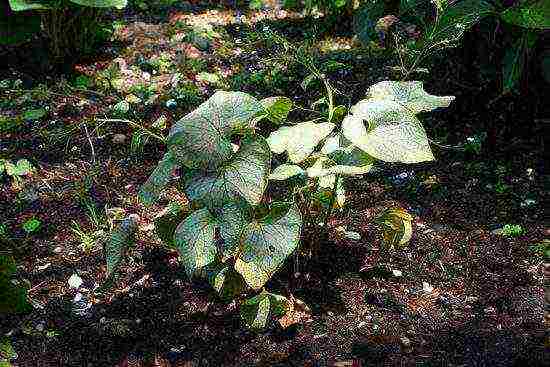
Bruner bushes need to be sprayed regularly
- moisten young bushes by spraying in case there is not enough moisture or a sultry summer. Watering - moderate, once every 10-14 days;
- feed Bruner with complex mineral fertilizers. She responds well to feeding, so 3-4 times per season will be quite enough;
- mulch the ground around the bush to maintain constant moisture. Do not forget that the roots of bruners are located close to the surface of the earth, so moisture is vital for them to obtain nutrients.
Brunera is a winter-hardy plant that can withstand frosts down to -30 ° C. This suggests that it is not worth covering it, but it is possible to mulch the root zone.
The flower is not prone to diseases, however, in hot and rainy summers, it can get sick with powdery mildew or brown spot. An excellent solution in this case is copper-containing preparations. In this case, spraying should be repeated after 10-14 days in order to avoid relapse.
Bruner in the garden, or a story about those who are able to keep her company
A perennial brunera is a great option for landscaping complex areas of the garden, as well as creating a true miracle near a barbecue area, pool or gazebo.To do this, it is enough to pick up interesting plants in a company with a Bruner, the neighborhood with which she will be glad.
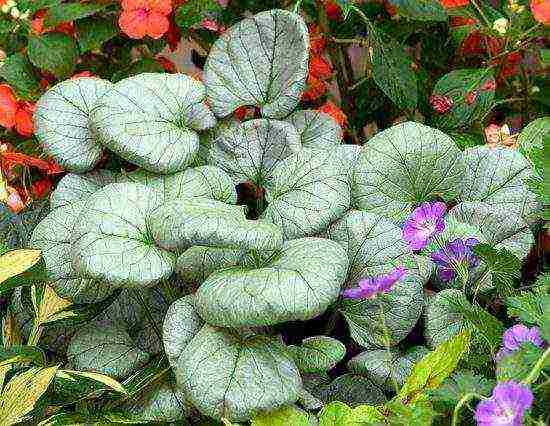
Brunera goes well with many other plants
Such plants can be:
- periwinkle, undersized salvia, ranunculus - on the first line;
- some of the perennials, the height of which will not reach 30 cm. An excellent option is tulips, lilies of the valley and even snowdrops, which are well suited to a semi-shady and humid place;
- tea or curly roses in the background. Bruner greens and roses will create a single gamut, but flowers will delight you with contrast.
The creation of landscape design in a certain style is a delicate and multifaceted matter. But in a few years, you can create a real natural masterpiece on your site, consisting of annual flowers and perennial plants, shrubs and stunted trees, even large trees. Why not?
And later, while enjoying relaxing in the garden, you will remember that it all started with a forget-me-not flower. A bush flower that I liked with the shades of foliage and cute flowers.
Planting bruners in open ground: video
Planting a large-leaved brunner will become a real lifesaver for a gardener, whose plot is covered with shade in the afternoon, groundwater accumulates in the lowlands. In a word, the flower will grow well where the root system of many plants will rot.
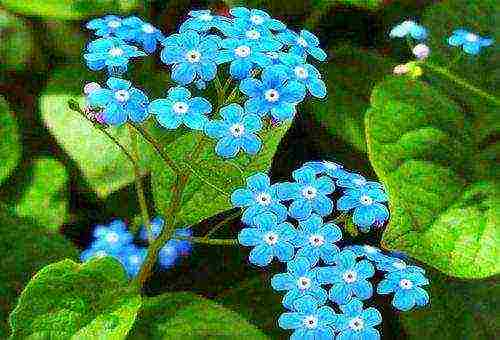
Often such places are empty, flower beds are bare, and some owners go for tricks and plant artificial bushes. But the modest Brunner has long been known to landscape designers who use her unpretentiousness when landscaping parks. Recently, this plant has been widely used to decorate alpine hills; it is planted on the banks of ponds and lakes.
Modest beauty from the Caucasus
The Borage family, and botanists attributed the Brunner (Bruner) to it, includes only three species of this flower. But the breeders did their best - several varieties and many hybrids were born. The beauty of a herbaceous plant is not immediately noticeable, being in the mountains, you can pass by and not see its modest charm: pubescent large stems with huge silver leaves in the form of a heart grow right from the ground. Below the leaf blade is even more pubescent, it seems gray in appearance, and velvety to the touch.

Advice! When decorating garden paths, you can use two types of brunner (brunella): large-leaved and Siberian. Small differences between species will only emphasize the individuality of each, but at the same time, their combination will give the composition a logical completeness.
The homeland of the plant is the slopes of the Caucasus mountains. It has long gained popularity among gardeners in European countries, as well as on other continents. It is grown not only in order to cover shady, swampy areas, but because of a short, memorable flowering. It begins at the end of April and lasts only a month: among the wide silver leaves sprout peduncles with delicate lilac buds, collected in graceful inflorescences (panicle or scutellum). The most popular varieties among breeders:
- Millennium Zilber - has leaves with neat splashes of white spots.
- Langtries is the owner of transparent silvery "dewdrops" on the rims of the leaves.
- Hudspan Cream - famous for the openwork creamy pattern on the edges of the huge leaf plates.

Brunner large-leaved differs from other types of minimal loss of decorative leaves. Some of them dry up and die off along with the inflorescences, but after a short time the plant grows green mass again. And the end of August or the beginning of September will delight you with the second wave of lilac buds formation. In Western countries, the plant is dug up in late autumn, and transplanted into flowerpots - flowering will be on Christmas Eve.
Convenient location
To make it easier to care for the plant in the future, you need to choose a suitable site for growing it.Places plentifully flavored with organic matter will not work - large-leaved brunner will grow a powerful leaf mass, and flowering will be scarce or disappear altogether. The most successful planting will be in heavy clay soil, on which moisture is retained. Usually, such soils are located in shady places, where the sun looks only in a sultry afternoon.
Advice! The flower is so unpretentious that it grows even in direct sunlight. Its wide leaf plates evaporate a large amount of moisture, so watering in such areas should be done daily.
Brunner's delicate leaves respond well to high humidity. The plant will become a real boon for the owners of gardens, on the territory of which reservoirs are located: their shores will be decorated with luxurious bushes with delicate inflorescences. Some growers plant in large flowerpots and place them around swimming pools and recreation areas. Taking into account the pleasant aroma exuded by the inflorescences, a walk in such a garden will be remembered for a long time.
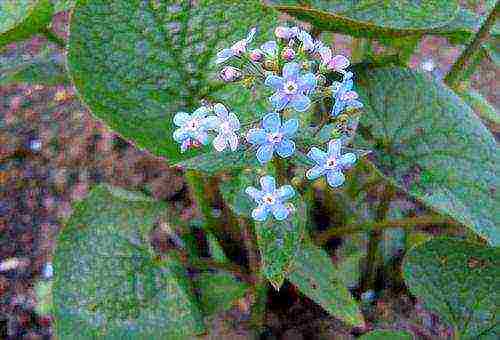
Breeding methods - it couldn't be easier
After flowering, Brunner forms fruits with small seeds. If they are not collected, self-sowing on the ground and further thickening of the planting will occur. Therefore, gardeners prefer to remove the boxes from the bushes in advance. The right time for sowing is late autumn. The fact is that successful cultivation implies the stratification of seeds; they need to stay in the cold for several months.
Advice! If planting is planned for the summer, you should put the seeds in the refrigerator for several months. Before that, you need to wrap them with cotton cloth.
Few flower lovers propagate large-leaved Brunner with seeds. The plant's rhizome is thick, fleshy and perfectly divided into several parts without any stimulants for root formation. The middle of summer is suitable for division, when flowering has ended. The algorithm of actions is as follows:
- Dig a flower out of the ground and cut off the entire leaf mass.
- The rhizome is thoroughly washed under running water and soaked briefly.
- A sterile instrument is divided into several parts (each of them must have a kidney).
- Pieces of rhizomes are planted in prepared places.
- Water abundantly.
If the original plant has grown a powerful root system, the procedure is even easier. Brunners removed from the soil wash off the remnants of the soil and soak for several hours. And then they are divided by the natural collapse of the rhizome. The resulting parts are planted in flower beds.
Secrets of proper care
Planted under spreading trees, Brunner does not need constant watering, it is produced only a few times per season. Since the flower does not require transplanting for more than 10 years, the choice of a shady area will reduce the care of the large-leaved brunner to a minimum. Direct sunlight quickly evaporates the moisture of the herb, so water it abundantly and often. Unlike most flowers, brunners do not require certain hours of water treatment. Even during the day, the wide leaves will keep the moist soil from cracking.
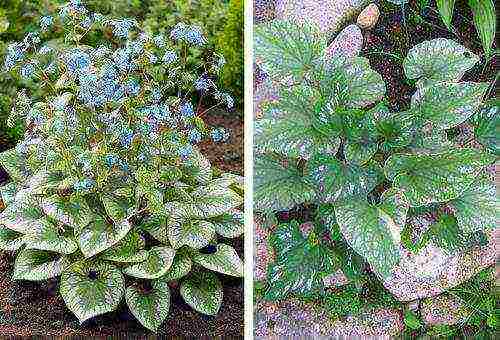
All kinds of weeds are very fond of the flower. They grow freely among the bushes, enjoying the shade and coolness. Care is complicated by constant weeding, since weeds take from the ground the minerals necessary for the growth of the large-leaved brunner. Experienced gardeners carry out soil mulching immediately after planting. To do this, you can use any material: needles of coniferous trees, hay, straw, leaves, high or low peat. The amount of weeds after mulching is significantly reduced.
Advice! With proper care, weeding and loosening is done with great care. The root system of the flower almost lies on the surface of the soil. Do not use too sharp objects, as well as deepen them more than 2-3 cm.
Brunner grows very quickly and can shade nearby plants. When planting and further care, you need to keep this in mind, leaving free space on the flower bed. To prevent the occurrence of fungal infections, constant thinning of herbaceous bushes is necessary. Timely removal of dried stems and inflorescences will also prevent the development of various putrefactive processes.

If the soil meets all the requirements of the flower, then the care does not imply the introduction of fertilizers. Only planting brunners on depleted or scarce soils may require additional fertilizing. It is best to use complex fertilizers, the concentration of the solution of which should be two times less than the prescribed one. They feed the flower a couple of times throughout the summer. Excessive saturation of the soil with mineral salts will immediately affect the state of the leaves - ugly rusty spots will appear on them.
However, such spots often indicate the emergence of problems of a different kind. From neighboring plantings or with improper care, various rot occurs on the plants:
- Powdery mildew. The leaf plate and the stem are, as it were, covered with small whitish crystals. The plant dries up and dies.
- Brown rot. The distribution of brown spots begins from the upper leaves and gradually covers the entire plant, leading to its death.

Severely damaged flowers must be removed from the ground and then burned far from the planting site. The surviving specimens should be treated with a modern fungicidal preparation. Comprehensive care includes a weekly routine check-up to detect:
- Aphids. Tiny transparent pests live on the most delicate parts of the brunner, feeding on their juices and causing a gradual withering away.
- Spider mite. Often attacks flowers with improper planting or poor watering. It is easy to detect the pest by the traces left - thin shiny cobwebs.
At this stage of care, the destruction of plants is not required. It is necessary to spray Brunner with a solution of a preparation with insecticidal activity. When growing flowers near potato plantations or tomato beds, the likelihood of rot is increased. For prevention, you can treat plants with fungicides a couple of times over the summer.
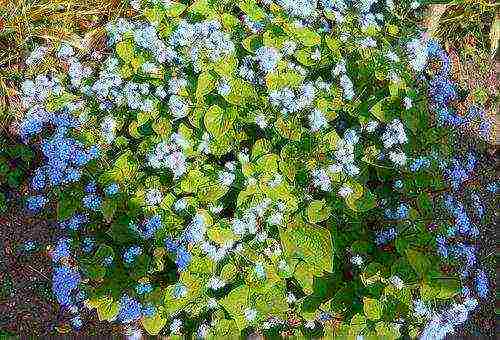
Growing perennial brunners in garden plots does not require special preparations for the upcoming wintering. The flower is frost-resistant, only cutting leaves is required from the owner. It is better not to allow repeated August flowering, so that the plant does not waste energy on laying buds, but prepares for winter. If the soil has not been mulched before, then it must be done before the onset of frost.
If the gardener wants to surprise his loved ones with the flowering of a large-leaved brunner near the New Year tree, then the bush is transplanted into a flowerpot. It should be kept in a cool place at a temperature of 6-7 ° C for about a month. And then transfer to a warm room and wait for flowering. The surprise will be great.
Growing a Brunner gives the breeder a lot of opportunities to use it. Caring for an unassuming plant will be minimized. When composing compositions on flower beds, lungwort and various varieties of ferns will become excellent neighbors of the flower. Planting a brunner will be a good reason to get your own pond.
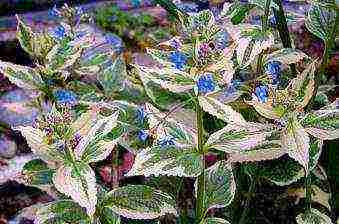
Are you looking for the most unpretentious plant for your garden? Then you will love Brunner. This flower was named after the botanist S. Brunner, who found it in the Crimea in the 18th century. The graceful and delicate plant attracts with bright color of small flowers and beautiful leaves in the form of hearts. Bruner, planting and care in the open field, which will not be difficult, will make your flower bed original.
When and how to plant Brunner
This flower is grown mainly by seeds, if sown immediately in open ground. This is best done in the fall.If you decide to plant a Brunner in the spring, you will have to act in a different way. Seeds need stratification for 3-4 months. To do this, put the bruner seeds in the refrigerator for the whole winter or plant them in a box and bury them in the snow.
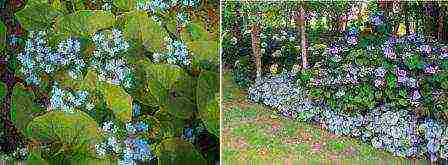
Also read: Indoor flowers, chlorophytum care
If you decide to transplant a flower, then do it at the end of summer. The spring transplant will contribute to the development of various diseases. Repot the bruner as soon as it fades. Dig up a bush, cut off the leaves, soak the roots in water, and then separate them. Plant a flower in the same or a different flower bed. Each part of the root must have a bud for the plant to take root. After transplanting into individual holes, water the flower well.
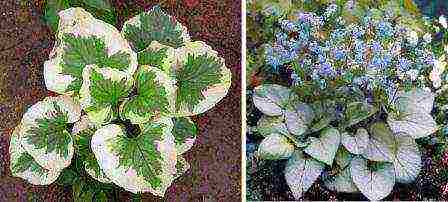
How to care for a Brunera flower
There are several types of bruners, each care has its own characteristics. The Siberian flower is not afraid of frost and does not need abundant watering, since it has enough natural precipitation. A large-leaved variety of a flower must be weeded out of weeds, which can drown out the plant. The root system of the bruner is very close to the topsoil, so it is best not to loosen the soil around the plant.
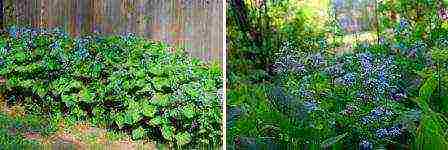
If the summer is very rainy, there is a likelihood of developing Brunera diseases. If you notice various kinds of spots on the leaves, remove the affected leaves and treat with special compounds. Another disease of Bruner is powdery mildew.
Brunner is an unpretentious plant and frost-resistant, therefore, does not require special preparation. It is enough to mulch with peat, humus or compost.

Brunner looks beautiful not only in the open field, but also in flowerpots or hanging pots. Do-it-yourself flower care is quite simple, so this perennial is widely used by gardeners.

